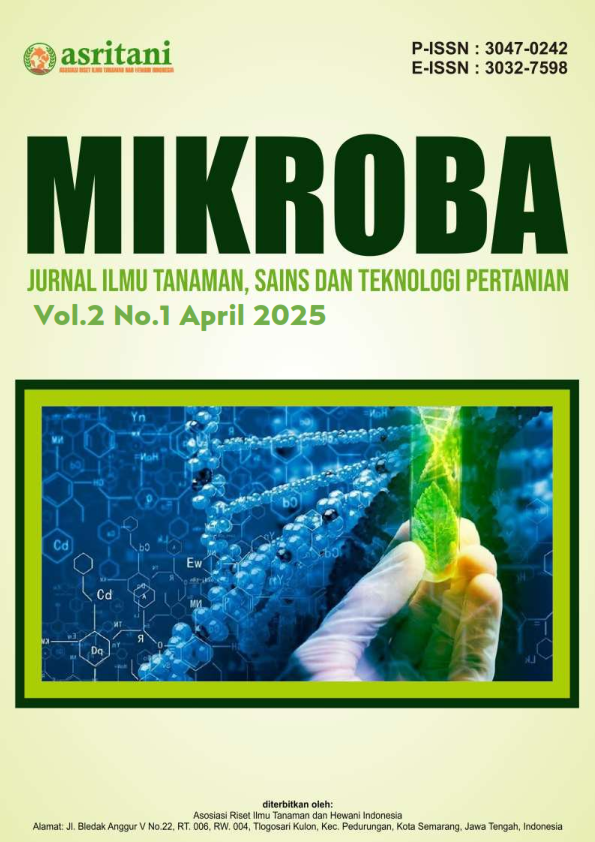Review Artkel Efek Sinergis Ekstrak Nabati terhadap Pengendalian Bakteri Patogen pada Produk Pertanian dan Kesehatan
DOI:
https://doi.org/10.62951/mikroba.v2i1.248Keywords:
vegetable extracts, aloe vera, bandotan, pathogenic bacteria, control of microorganismsAbstract
Vegetable ingredients are natural sources of active compounds that have the potential to be used as control agents for pathogenic microorganisms in various fields, including health and agriculture. This study aims to evaluate the synergistic effect between aloe vera (Aloe vera L.) and bandotan (Ageratum conyzoides L.) extracts on inhibiting the growth of pathogenic bacteria in different media. Aloe vera extract is obtained using the infundation method, while bandotan extract is obtained using the maceration technique. The concentrations tested were 30%, 45%, and 60% for each extract, as well as a combination of both. Testing was carried out on two main applications: as an antiseptic hand sanitizer by testing germ colonies using Plate Count Agar (PCA), and as a bacteria control Erwinia carotovora, the cause of carrot tuber rot, using the Path Ways Analysis test. The results showed that the combination of aloe vera and bandotan extracts had more significant inhibitory effectiveness than single extracts in both applications. A combination concentration of 60% gave the best results with a reduction in bacterial colonies of up to 90%. The mechanism of action of active compounds such as flavonoids, phenolics and saponins in this vegetable extract plays an important role in damaging bacterial cell membranes and inhibiting the metabolism of microorganisms. This research confirms the potential of using local plant materials as an environmentally friendly and economical solution for controlling pathogenic bacteria in the health and agricultural sectors.References
Adfa, M., Kusnanda, A. J., Livandri, F., Rahmad, R., Darwis, W., Efdi, M., Ninomiya, M., & Koketsu, M. 2017. Insecticidal activity of toona sinensis against coptotermes curvignathus holmgren. Rasayan Journal of Chemistry, 10(1), 153–159. https://doi.org/10.7324/RJC.2017.1011590
Ahmad, F., Fouad, H., Liang, S. Y., Hu, Y., & Mo, J. C. 2021. Termites and Chinese agricultural system: applications and advances in integrated termite management and chemical control. Insect Science, 28(Issue 1), 2–20. https://doi.org/10.1111/1744-7917.12726
Arifan, F., Setyati, A. W., Broto, R. TD. W., & Dewi, A. L. 2020. Pemanfaatan Nasi Basi Sebagai Mikro Organisme Lokal (MOL) Untuk Pembuatan Pupuk Cair Organik di Desa Mendongan Kecamatan Sumowono Kabupaten Semarang. Jurnal Pengabdian Vokasi, 1(4), 252-255.
Atifah, Y., Ginting, N., & Harahap, F. S. 2017. Efektifitas Air Cucian Beras Sebagai Pestisida Alami Terhadap Hama Ulat Daun Sawi. Eksakta : Jurnal Penelitian dan Pembelajaran MIPA, 2(2), 109-114.
Laily, A. M. F., & Palupi, H. T. 2019. Mempelajari Pemanfaatan Air Cucian Beras (Leri) Pada Proses Pembuatan Nata de Leri. Jurnal Teknologi Pangan, 10(Issue 1), 35-40.
Khater, H. F. 2012. Prospects of botanical biopesticides in insect pest management. Journal of Applied Pharmaceutical Science, 3(12), 641-656. https://doi.org/10.7324/japs.2012.2546
Lalla, M. 2012. Potensi Air Cucian Beras Sebagai Pupuk Organik Pada Tanaman Seledri (Apium graveolens L.). Jurnal Agropolitan, 5(1), 38-43.
Miftah, A. M., Khalisah, A. N., Hamia, Masita, & Chalsum, U. 2019. Efektivitas Daun Sirih (Piper betle L.) dan Air Leri terhadap Mortalitas Rayap Tanah (Coptotermes sp.). Indonesian Journal of Fundamental Sciences, 5(1), 67-72.
Hadi, R. A. 2019. Pemanfaatan Mol (Mikroorganisme Lokal) Dari Materi Yang Tersedia Di Sekitar Lingkungan. Agroscience, 9(1), 93-104.
Mutiarahmi, C. N., Hartady, T., & Lesmana, R. 2021. Kajian Pustaka: Penggunaan Mencit Sebagai Hewan Coba di Laboratorium yang Mengacu pada Prinsip Kesejahteraan Hewan. Indonesia Medicus Veterinus, 10(1), 134–145. https://doi.org/10.19087/imv.2020.10.1.134
Zulkahfi, Suparmin, S., Suparmin, S., & Astuti Arif. 2017. Pengendalian Serangan Rayap Tanah Coptotermes sp. Menggunakan Ekstrak Daun Belimbing Wuluh (Averrhoa bilimbi L). Hasanuddin Student Journal, 1(1), 1–8. http://journal.unhas.ac.id/index.php/jtHSJ
Tampubolon, K., Sihombing, K. N., Purba, Z., Samosir, S. T. S., & Karim, S. 2018. Potensi metabolit sekunder gulma sebagai pestisida nabati di Indonesia. Jurnal Kultivasi, 17(3), 683-693.
Purwanto, P. A., Maida, S., Manulang, M. K., Thamrin, N. T. (2019). Pengaruh Pemberian Mikroorganisme Lokal (MOL) Nasi Terhadap Pertumbuhan dan Produksi Tanaman Kacang Hijau (Vigna radiata L.). Prosiding Seminar Nasional Volume 4 No. 1 (pp. 305-313). Sulawesi Selatan: Universitas Cokroaminoto Palopo.
Yasmin, A., Alfalaqi, H. M., Taufiqulhakim, Z., & Elfarisna. (2022). Inovasi Pertanian Melalui Pembuatan Mikro Organisme Lokal (Mol) Pada Masyarakat Di Desa Curug Wetan. Seminar Nasional Pengabdian Masyarakat LP UMJ. Pp. 1-7. Jakarta: Universitas Muhammadyah Jakarta. http://jurnal.umj.ac.id/index.php/semnaskat.
N. Wayan, D. Bintari, R. Kawuri, M. W. Proborini, J. Biologi, dan U. Udayana, “Isolasi dan Identifikasi Bakteri Penyebab Busuk Lunak pada Umbi Wortel (Daucus carota L.) Varietas Lokal di Bali,” Metamorf. J. Biol. Sci., vol. 2, no. 1, hal. 9–15, 2015.
U. R. Hutauruk, F. J. Yu, O. Natali, dan S. W. Nasution, “Effectiveness Comparison of Bandotan Leaves With Aloe Vera in Repair of Burn Wound on Rats Based on Burn Wound Diameter,” Jambura J. Heal. Sci. Res., vol. 4, no. 3, hal. 656–667, 2022, doi: 10.35971/jjhsr.v4i3.12739.
Downloads
Published
How to Cite
Issue
Section
License
Copyright (c) 2025 Mikroba : Jurnal Ilmu Tanaman, Sains Dan Teknologi Pertanian

This work is licensed under a Creative Commons Attribution-ShareAlike 4.0 International License.





